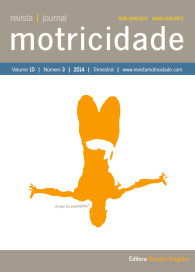Influence of Subcutaneous Fat Layer in Skin Temperature
DOI:
https://doi.org/10.6063/motricidade.5999Abstract
The aim of this study was to determine the correlation between the subcutaneous fat layer and the temperature variation (core - skin) in two body regions, measured by infrared sensors. This study involved 43 volunteers selected among undergraduate students in physical education. The thermal images and skinfold thickness were acquired from subscapular region (SB) for male and triceps region (TR) for female volunteers, of right side. In this study, subscapular skinfold thickness was inversely correlated with skin temperature (r = -0.638, p = 0.004) and directly correlated with ΔT [core – skin] (r = 0.653, p = 0.003). However, the results for the triceps region showed no significant correlation between triceps skinfold thickness and skin temperature or ΔT [core – skin]. When the sample was separated into two groups by skinfold thickness, with cut off at 12mm, average comparison tests for ΔT [core – skin] shows statistically significant difference between groups for the subscapular site (Student t test for independent sample, p value = 0.023), but not for the triceps site (Wilcoxon Signed Ranks and the Mann-Whitney tests, p value = 0.268). In short, the findings suggest that subcutaneous fat layer correlates negatively with skin temperature in subscapular region.
Downloads
Published
Issue
Section
License
The authors of submitted manuscripts must transfer the full copyright to Journal Motricidade / Desafio Singular Editions. Granting copyright permission allows the publication and dissemination of the article in printed or electronic formats and copyrights start at the moment the manuscript is accepted for publication. It also allows Journal Motricidade to use and commercialize the article in terms of licensing, lending or selling its content to indexation/abstracts databases and other entities.
According to the terms of the Creative Commons licence, authors may reproduce a reasonable number of copies for personal or professional purpose but without any economic gains. SHERPA/RoMEO allows authors to post a final digital copy (post-printing version) of the article in their websites or on their institutions' scientific repository.


